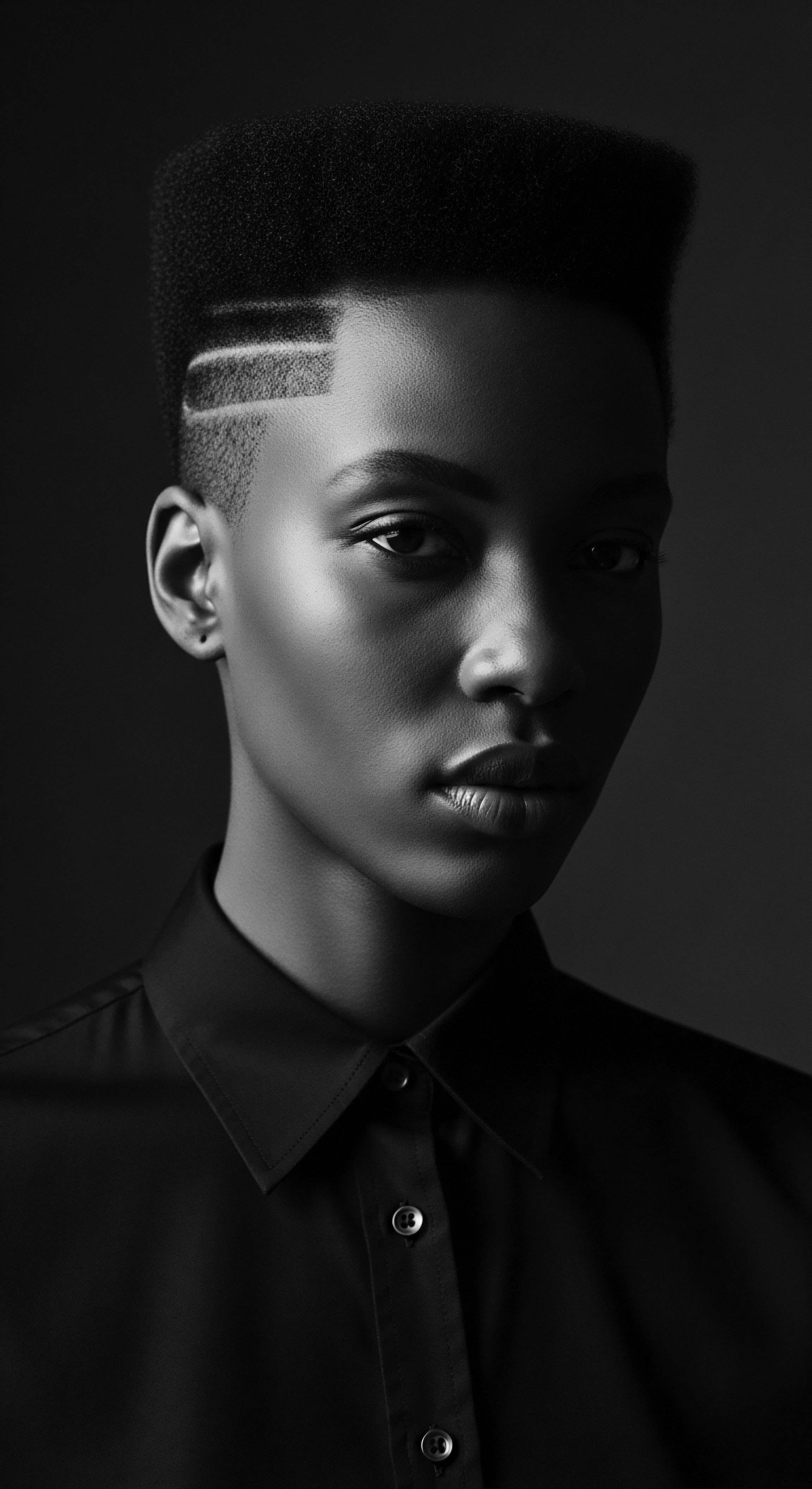
Fundamentals
Cleansing Rituals, within the expansive living library of Roothea, refer to the foundational practices and ancestral wisdom surrounding the purification of textured hair and scalp. This involves not merely the removal of impurities, but a holistic approach that acknowledges hair as a living extension of self, deeply interwoven with identity, spirit, and community. The initial understanding of these rituals begins with their elemental purpose ❉ to prepare the scalp and strands for nourishment, growth, and stylistic expression.
For generations, particularly within Black and mixed-race communities, cleansing has extended beyond a mere hygiene routine. It has always been a deliberate act of care, often communal, utilizing ingredients sourced directly from the earth. The very act of washing hair was, and remains, a sacred moment, a pause for introspection and connection to inherited practices.

Early Understandings of Hair Purification
From the earliest records, cleansing the hair was understood as essential for maintaining its vitality. Ancient African societies recognized the delicate balance of the scalp and the need to preserve the natural oils that protect textured strands. Their methods were often gentle, designed to refresh without stripping the hair of its inherent moisture.
Cleansing Rituals represent a profound dialogue between ancestral wisdom and the enduring needs of textured hair.
The basic definition of a Cleansing Ritual, therefore, encompasses the methodical application of natural agents to hair and scalp, aiming to dislodge debris, excess oils, and environmental residues. This fundamental action sets the stage for all subsequent care, ensuring the hair can absorb beneficial treatments and flourish.

Elemental Ingredients for Early Cleansing
Early cleansing practices relied on the immediate environment, employing a variety of botanical and mineral resources. These substances were chosen for their gentle efficacy and their ability to honor the hair’s inherent structure.
- Rhassoul Clay ❉ Sourced from the Atlas Mountains of Morocco, this mineral-rich clay was used as a mud wash, cleansing the hair and scalp without stripping its natural properties.
- African Black Soap ❉ A traditional West African soap, often made from plantain skins, cocoa pods, and shea butter, recognized for its ability to remove dirt and excess oil while soothing the scalp.
- Herbal Infusions ❉ Various leaves, roots, and barks, steeped in water, created mild rinses that purified while imparting beneficial properties.
- Ash and Lye from Plants ❉ Carefully prepared from plant ashes, these alkaline solutions were used in diluted forms for their purifying qualities, often mixed with oils or butters.
These basic elements formed the bedrock of hair care, illustrating an early comprehension of the hair’s unique needs. The careful selection of these ingredients reflects a deep respect for the natural world and its offerings for wellbeing.

Intermediate
Moving beyond the elemental, the intermediate meaning of Cleansing Rituals delves into their significance as structured, often communal, practices that shaped social identity and spiritual connection within textured hair heritage. These rituals were not merely about hygiene; they were acts of cultural preservation, expressions of status, and conduits for intergenerational knowledge transfer. The careful execution of these cleansing practices prepared hair not just for beauty, but for its role as a living symbol.
The communal aspect of cleansing, particularly among women, holds profound historical weight. These were moments of shared stories, advice, and strengthening bonds, where the physical act of hair care intertwined with the weaving of social fabric. This communal grooming, often performed by mothers, sisters, or close friends, reinforced kinship and community ties.

Cultural Interpretations of Cleansing
Across diverse African societies, the act of cleansing hair was imbued with rich cultural interpretations. Hair, positioned as the highest point of the body, was considered a spiritual antenna, a conduit for communication with the divine and ancestors. Therefore, the purification of hair became a spiritual act, ensuring clarity of connection and receptivity to wisdom.
Cleansing Rituals were communal acts, weaving together the physical care of hair with the enduring spirit of shared heritage.
The removal of accumulated dirt or negative energies through cleansing was understood to prepare the individual for significant life stages or ceremonial participation. This symbolic purification extended to preparing hair for intricate styles that communicated age, marital status, social standing, or tribal affiliation.

Evolution of Cleansing Methods in the Diaspora
The transatlantic slave trade drastically disrupted these ancestral practices, yet the spirit of cleansing and hair care persisted as an act of quiet resistance and identity preservation. Enslaved Africans were often stripped of their traditional tools and methods, with their hair forcibly shaved or neglected as a means of control. Despite this profound oppression, the ingenuity of those in the diaspora led to the adaptation of available resources for cleansing and care.
Early diasporic cleansing involved making do with limited resources, often repurposing household items or cultivating knowledge of local botanicals. The enduring drive to maintain hair, even under duress, speaks volumes about its inherent significance.
| Historical Context Pre-colonial Africa |
| Traditional Cleansing Agent/Method African Black Soap (from plantain, cocoa pod ash) |
| Significance in Heritage A holistic cleanser, honoring indigenous botanical knowledge. |
| Historical Context Pre-colonial Africa |
| Traditional Cleansing Agent/Method Rhassoul Clay (from Moroccan mountains) |
| Significance in Heritage Mineral-rich purification, maintaining scalp health without stripping oils. |
| Historical Context Early Diaspora (Adaptation) |
| Traditional Cleansing Agent/Method Lye Soap (often homemade, from animal fat and ash) |
| Significance in Heritage A harsh necessity, yet a testament to resourcefulness in maintaining hygiene. |
| Historical Context Early Diaspora (Adaptation) |
| Traditional Cleansing Agent/Method Herbal Rinses (e.g. rosemary, sage infusions) |
| Significance in Heritage Continuity of botanical wisdom, adapted to new environments. |
| Historical Context Mid-20th Century Diaspora |
| Traditional Cleansing Agent/Method Baking Soda and Apple Cider Vinegar Rinses |
| Significance in Heritage Accessible, gentle alternatives to harsh commercial shampoos, balancing pH. |
| Historical Context These agents, from ancient earths to resourceful adaptations, underscore the persistent dedication to hair wellness across generations. |
The transition from traditional African cleansing practices to those developed in the diaspora illustrates a remarkable resilience. While some traditional ingredients were unavailable, the underlying principle of respectful, nourishing cleansing remained. The meaning of cleansing shifted, too, becoming an act of quiet rebellion against forced assimilation, a way to hold onto a fragment of identity in a world that sought to erase it.

Academic
Within Roothea’s comprehensive archive, the academic definition of Cleansing Rituals extends beyond mere practical steps, positioning them as complex socio-cultural phenomena and bio-cosmetic processes deeply embedded within the historical and ontological frameworks of textured hair heritage. This elucidation considers the multi-layered significance of purification acts, from their physiological impact on the unique structure of coiled strands to their profound symbolic weight in articulating identity, community, and resistance across Black and mixed-race experiences. A Cleansing Ritual, in this scholarly context, represents a deliberate, often ancestral, engagement with the integumentary system, particularly the hair follicle and shaft, through the application of specific agents and methodologies, designed not only for hygienic maintenance but also for the preservation of cultural meaning, spiritual connection, and collective memory.
The precise delineation of Cleansing Rituals necessitates an understanding of the distinctive characteristics of textured hair. The helical structure of coiled hair, with its elliptical cross-section and propensity for dryness due to the tortuous path of natural sebum, requires a gentle yet effective cleansing approach. Traditional practices, often predating modern cosmetic science, intuitively addressed these biological realities.
For instance, the widespread historical use of saponins from plants or mineral clays like rhassoul clay, rather than harsh surfactants, exemplifies an empirical understanding of maintaining the hair’s lipid barrier while removing impurities. This traditional knowledge, passed down through generations, implicitly recognized the need for cleansing that supports the integrity of the cuticle and cortex, minimizing hygral fatigue and mechanical damage inherent to the hair’s geometry.

The Ontology of Hair and Cleansing as Identity Affirmation
The ontological significance of hair in African societies, where it was often perceived as the most elevated part of the body and a conduit for spiritual energy, directly informs the meaning of cleansing rituals. The act of purification was not merely superficial; it was believed to clear the pathway for spiritual interaction, enhancing vitality and connecting individuals to ancestral wisdom. This spiritual dimension elevates cleansing beyond the mundane, transforming it into a sacred practice that reaffirms one’s place within a cosmic and communal order.
For the Yoruba people of Nigeria, hair was as important as the head itself, with care for both believed to bring good fortune. Braided hair was even used to send messages to deities.
Cleansing Rituals are not merely hygienic acts; they are profound expressions of identity, resilience, and ancestral connection for textured hair.
This deep cultural meaning is underscored by historical accounts of hair’s weaponization during the transatlantic slave trade. The forcible shaving of hair by enslavers served as a primary act of dehumanization, a deliberate attempt to sever the spiritual and cultural connection to homeland and identity. Despite this systematic oppression, the act of cleansing and styling hair, even in secret, became a powerful form of resistance and cultural continuity. This historical context illuminates the profound import of cleansing rituals as acts of self-preservation and defiant affirmation of one’s heritage in the face of systemic erasure.

Case Study ❉ The Enduring Legacy of Communal Cleansing and Care in the Diaspora
A powerful illustration of the enduring connection between Cleansing Rituals and textured hair heritage lies in the “wash day” tradition prevalent among Black families in the African diaspora. This practice, often a multi-hour, multi-generational event, serves as a compelling case study of how cleansing transcends its basic function to become a repository of cultural knowledge, familial bonding, and identity formation.
Sociological research on Black hair practices, such as Zenda Walker’s observations in her children’s book “Know Your Hairitage ❉ Zara’s Wash Day,” highlights the ritualistic nature of this communal activity. Walker notes that for many children of African descent, “waking up on a Saturday or Sunday morning meant one thing ❉ wash day.” This ritual involved a female relative meticulously shampooing, rinsing, and detangling thick curls, often for hours, followed by the application of oils, conditioners, and styling. This shared experience, passed down from parents to children, is more than a hair care routine; it is a pedagogical space where techniques for managing textured hair are taught, stories are exchanged, and a sense of belonging is instilled. This communal grooming, a continuation of pre-colonial African practices where hair care was a shared responsibility among family and friends, fosters strong social bonds and a sense of belonging.
The continuity of this “wash day” ritual, despite centuries of displacement and attempts to devalue Black hair, offers tangible evidence of cultural resilience. It is a living testament to the enduring power of ancestral practices to shape contemporary identity. The intimate act of a mother cleansing her child’s hair, while perhaps not explicitly recognized as a “ritual” in the modern sense, carries the historical weight of generations of care, survival, and quiet defiance. This practice demonstrates how the Cleansing Ritual is not static; it adapts, persists, and continuously regenerates its meaning within the living context of Black and mixed-race families, embodying a profound legacy of self-care and communal strength.

Biochemical Underpinnings and Traditional Efficacy
From a scientific perspective, the efficacy of traditional cleansing agents in relation to textured hair’s unique biology is increasingly understood. The tightly coiled nature of Afro-textured hair means that natural oils produced by the scalp do not easily travel down the hair shaft, leading to inherent dryness. Conventional shampoos, often containing harsh sulfates, can exacerbate this dryness by stripping away vital lipids, leading to cuticle damage and increased susceptibility to breakage.
Traditional African cleansing agents, however, often employed milder alternatives.
- Saponin-Rich Plants ❉ Many African plants contain saponins, natural compounds that produce a gentle lather and possess cleansing properties without the harshness of synthetic detergents. These plants were often crushed and mixed with water to create a cleansing infusion.
- Clays (e.g. Rhassoul) ❉ These natural minerals work by absorbing impurities and excess oil without completely stripping the hair, helping to maintain the scalp’s natural pH balance and preserving moisture.
- Fermented Rinses ❉ Some traditions incorporated fermented ingredients, which can contribute beneficial acids and enzymes, helping to gently exfoliate the scalp and condition the hair.
- Oils and Butters as Cleansers ❉ In certain contexts, rich oils and butters like shea butter or ghee were used in a “pre-poo” or even “co-wash” manner, massaged into the scalp to loosen dirt before a water rinse, thereby protecting the hair from the stripping effects of water alone.
The understanding of these cleansing methods reveals an intuitive, empirically derived knowledge of hair science. The objective of these historical cleansing rituals was not merely to make hair “clean” by Eurocentric standards, which often valued a squeaky-clean feel that was detrimental to textured hair. Instead, the goal was to prepare the hair for optimal health, manageability, and receptivity to styling, ensuring its longevity and symbolic presentation. This nuanced comprehension of cleansing, deeply rooted in ancestral practices, stands as a testament to the sophistication of traditional hair care systems.
| Aspect Primary Objective |
| Traditional Cleansing Rituals (Heritage Focus) Holistic purification, spiritual alignment, community bonding, preparation for symbolic styling. |
| Modern Cleansing Approaches (Contemporary Perspective) Removal of dirt, oil, product buildup, scalp health, aesthetic readiness. |
| Aspect Typical Agents |
| Traditional Cleansing Rituals (Heritage Focus) Plant-derived saponins, clays (e.g. rhassoul), herbal infusions, diluted plant ashes, natural butters/oils. |
| Modern Cleansing Approaches (Contemporary Perspective) Shampoos (sulfate-free, low-poo, co-wash), cleansing conditioners, micellar waters. |
| Aspect Impact on Hair's Natural Oils |
| Traditional Cleansing Rituals (Heritage Focus) Preserves natural sebum, gently purifies without stripping, maintains moisture balance. |
| Modern Cleansing Approaches (Contemporary Perspective) Varies widely; harsh sulfates strip oils, gentle cleansers aim to preserve. |
| Aspect Communal/Social Dimension |
| Traditional Cleansing Rituals (Heritage Focus) Often a shared, intimate activity, fostering intergenerational learning and social cohesion. |
| Modern Cleansing Approaches (Contemporary Perspective) Primarily individualistic, though shared experiences in salons exist. |
| Aspect Philosophical Underpinning |
| Traditional Cleansing Rituals (Heritage Focus) Hair as sacred, living entity, connection to ancestors, identity marker, spiritual conduit. |
| Modern Cleansing Approaches (Contemporary Perspective) Hair as an aesthetic feature, health indicator, expression of personal style. |
| Aspect The modern understanding of cleansing for textured hair often seeks to replicate the gentle, nourishing effects inherent in ancestral practices, recognizing the wisdom embedded within historical traditions. |
The rigorous examination of Cleansing Rituals reveals a rich intersection of biology, culture, and history. Their persistent practice, despite immense pressures to conform to Eurocentric beauty standards, speaks to their profound functional and symbolic value. Understanding these rituals requires looking beyond superficial definitions, embracing their deep roots in human experience and the enduring story of textured hair.

Reflection on the Heritage of Cleansing Rituals
The journey through the Cleansing Rituals, from their elemental beginnings to their intricate academic delineations, culminates in a profound meditation on the enduring soul of a strand. These acts of purification are not relics of a distant past; they are living legacies, echoing the resilience and ingenuity of Black and mixed-race communities across time and geography. The heritage woven into each wash, each rinse, each application of natural balm, speaks volumes about a people’s unwavering connection to their hair as a symbol of self, spirit, and survival.
From the earthen clays and plant-derived lathers of ancient Africa to the adapted “wash day” traditions in diasporic kitchens, the thread of respectful, intentional cleansing has remained unbroken. It is a testament to the deep-seated understanding that hair is more than keratin; it is a canvas for cultural expression, a record of lineage, and a point of resistance against forces that sought to diminish its inherent beauty. The meticulous care, often communal and intergenerational, fostered not only healthy hair but also robust bonds of kinship and shared identity.
The contemporary natural hair movement, with its resurgence of traditional practices and renewed appreciation for ancestral ingredients, is a vibrant continuation of these ancient cleansing rituals. It is a conscious return to the wisdom of those who understood that true beauty and wellness spring from an alignment with one’s authentic self and one’s historical roots. Each time textured hair is gently cleansed, detangled, and nourished, it is a whisper to the ancestors, a celebration of resilience, and a powerful affirmation of identity for future generations. The meaning of these rituals continues to unfold, revealing new layers of significance with each passing year, cementing their place as cornerstones of textured hair heritage.

References
- Byrd, A. D. & Tharps, L. (2014). Hair Story ❉ Untangling the Roots of Black Hair in America. St. Martin’s Griffin.
- Ellis, A. B. (1894). The Yoruba-speaking Peoples of the Slave Coast of West Africa ❉ Their Religion, Manners, Customs, Laws, Language, Etc. Chapman and Hall.
- Essel, S. (2017). Afrocultural Aesthetics ❉ A Study of Beauty Standards in Pre-colonial Ghana. University of Ghana Press.
- Hallpike, C. R. (1969). Social Hair. Man, 4(2), 256-264.
- Rooks, N. M. (1996). Hair Raising ❉ Beauty, Culture, and African American Women. Rutgers University Press.
- Sherrow, V. (2006). Encyclopedia of Hair ❉ A Cultural History. Greenwood Press.
- Sieber, R. & Herreman, F. (2000). Hair in African Art and Culture. Museum for African Art.
- Thompson, K. (2009). Black Women, Beauty, and Hair ❉ A Sociological Exploration of Identity and Self-Perception. University Press of America.
- Walker, Z. (2021). Know Your Hairitage ❉ Zara’s Wash Day. Independently Published.
- White, S. & White, D. (1995). Slave Narratives and the Construction of Black Hair Identity. University of Pennsylvania Press.
